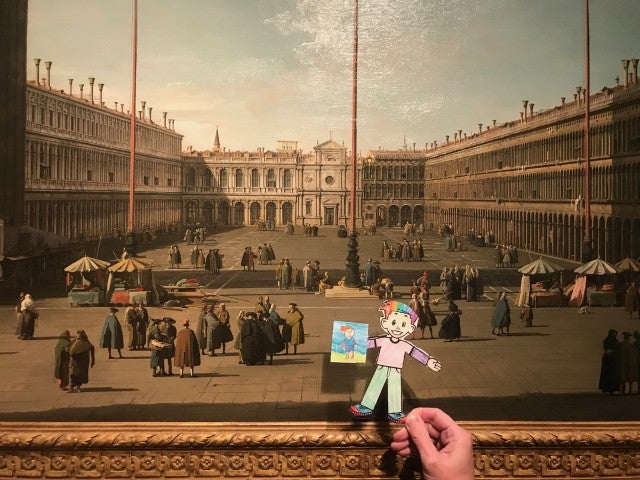From the Director, December 2018
Updated Jul 20, 2022
Travel the world at the DIA
Some of you may be familiar with the children’s books about Flat Stanley, who travels around the world after being flattened by a bulletin board. Teachers have engaged young learners for decades by sharing the books with them and having students create their own Flat Stanleys, which they mail to friends and family around the globe. The recipients then take photos of Stanley in various locations and send the images (and Stanley) back to the student so that they can create their own chronicle of his travels.
Recently, a student at Detroit’s Cesar Chavez Academy, Mylene, sent me her Flat Stanley, asking me to take him on some adventures, take photos and send them back to her. Not being familiar with the story from my childhood in Spain, I took some time to learn a little about Flat Stanley and realized that this second grader had made an inspired choice when she decided to send her Flat Stanley to me here at the DIA.
In a matter of hours, Flat Stanley had traveled nearly the entire world without ever leaving Mylene’s hometown of Detroit. He visited the extraordinary Piazza di San Marco (town square) in the city of Venice (Italy), and I took them around the merchants there who were, probably, selling rich textiles from Italy, Turkey and other places in Asia. This is perhaps one of the most famous spots in the world, admired by tourists for many centuries. From Italy we traveled to Egypt, one of the oldest known civilizations, and we were welcomed by our amazing mummy. We then traveled to our new Asian galleries where we stopped and saw a beautiful Samurai helmet which prominently shows an amazing clam shape decoration. The arts of Japan are so carefully created – it seems that time ceases when one pays attention to them. Of course, on arriving to Japan, we also travelled through India, China and many other countries. In our way back to America, we stopped in Ghana (Africa), highlighted in the DIA’s Great Hall by a work, Amemo (Mask of Humankind) by the Ghanaian artist, El Anatsui. From there we admired the heart of the museum, the Diego Rivera murals, a masterpiece that brings together the strength of the U.S. working class with the powerful art of Mexico.
Here at the DIA, it is our privilege to share the history and culture of the world with the thousands of students here on field trips and our general visitors. Our collection is extraordinary, as we’ve worked to ensure it includes excellent pieces that represent the best of human creativity that connects with the backgrounds and cultures of our surrounding communities. Here on Woodward Avenue, the history and cultures of the world are at the tips of your fingers.
Mylene’s letter closed with “I hope you enjoy your adventure with Flat Stanley.” I look forward to having Mylene bring him back here herself with her family and friends to on her own adventure around the globe with my new friend.


DIA Director, Salvador Salort-Pons in Rivera Court
Travel the world at the DIA
Some of you may be familiar with the children’s books about Flat Stanley, who travels around the world after being flattened by a bulletin board. Teachers have engaged young learners for decades by sharing the books with them and having students create their own Flat Stanleys, which they mail to friends and family around the globe. The recipients then take photos of Stanley in various locations and send the images (and Stanley) back to the student so that they can create their own chronicle of his travels.
Recently, a student at Detroit’s Cesar Chavez Academy, Mylene, sent me her Flat Stanley, asking me to take him on some adventures, take photos and send them back to her. Not being familiar with the story from my childhood in Spain, I took some time to learn a little about Flat Stanley and realized that this second grader had made an inspired choice when she decided to send her Flat Stanley to me here at the DIA.
In a matter of hours, Flat Stanley had traveled nearly the entire world without ever leaving Mylene’s hometown of Detroit. He visited the extraordinary Piazza di San Marco (town square) in the city of Venice (Italy), and I took them around the merchants there who were, probably, selling rich textiles from Italy, Turkey and other places in Asia. This is perhaps one of the most famous spots in the world, admired by tourists for many centuries. From Italy we traveled to Egypt, one of the oldest known civilizations, and we were welcomed by our amazing mummy. We then traveled to our new Asian galleries where we stopped and saw a beautiful Samurai helmet which prominently shows an amazing clam shape decoration. The arts of Japan are so carefully created – it seems that time ceases when one pays attention to them. Of course, on arriving to Japan, we also travelled through India, China and many other countries. In our way back to America, we stopped in Ghana (Africa), highlighted in the DIA’s Great Hall by a work, Amemo (Mask of Humankind) by the Ghanaian artist, El Anatsui. From there we admired the heart of the museum, the Diego Rivera murals, a masterpiece that brings together the strength of the U.S. working class with the powerful art of Mexico.
Here at the DIA, it is our privilege to share the history and culture of the world with the thousands of students here on field trips and our general visitors. Our collection is extraordinary, as we’ve worked to ensure it includes excellent pieces that represent the best of human creativity that connects with the backgrounds and cultures of our surrounding communities. Here on Woodward Avenue, the history and cultures of the world are at the tips of your fingers.
Mylene’s letter closed with “I hope you enjoy your adventure with Flat Stanley.” I look forward to having Mylene bring him back here herself with her family and friends to on her own adventure around the globe with my new friend.


